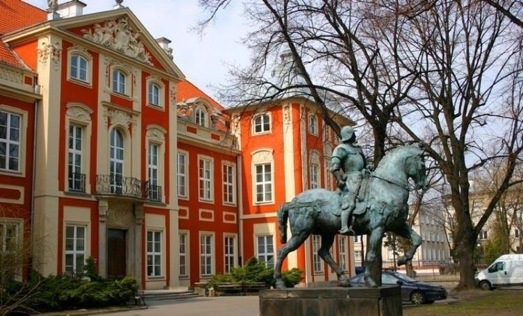
PL
Palac Czapskich nazywany takze palacem Krasinskich lub Raczynskich znajduje sie w Warszawie przy Krakowskim Przedmiesciu 5.
W XVII wieku na miejscu obecnego palacu miescil sie drewniany dwór Radziwillów. W latach ok. 1680-1705 dla prymasa Michala Radziejowskiego wzniesiono murowany palac, najprawdopodobniej wedlug projektu Tylmana z Gameren. W 1712 teren zostal wlasnoscia hetmana wielkiego koronnego Adama Sieniawskiego. Zajal sie on przebudowa palacu i oficyn (nastapila w latach 1713-1721). Stworzyl oficyny frontowe, dziedziniec gospodarczy i reprezentacyjny, zalozyl ogród. Po jego smierci w 1726 roku, posiadlosc odziedziczyla jego córka Zofia (bedaca zona Augusta Czartoryskiego). W roku 1732 malzenstwo Czartoryskich sprzedalo palac bankierowi Piotrowi de Riacour.
W 1733 roku budynek kupila rodzina Czapskich. Rozpoczeli kolejna przebudowe wnetrza palacu jak i jego otoczenia. W latach 1752-1756 nadano mu póznobarokowy wystrój. Brame glówna udekorowano kamiennymi orlami. Czapski zmarl w roku 1784. Budynek odziedziczyla jego córka Konstancja, zona marszalka Sejmu Stanislawa Malachowskiego. Od tego czasu w palacu odbywaly sie narady, projekty Kontytucji i ustaw, wystawne obiady. W roku 1790 architekt Jan Chrystian Kamsetzer wybudowal dwie oficyny w stylu klasycystycznym; przebudowal takze brame.
Od roku 1809, po smierci Stanislawa Malachowskiego, palac stal sie wlasnoscia rodziny Krasinskich. Stal sie jednym z osrodków zycia kulturalnego Warszawy. Odbywaly sie w nim spotkania literackie pisarzy i poetów organizowane przez Wincentego Krasinskiego, ojca Zygmunta Krasinskiego. Rodzina ta zgromadzila w palacu zbiory biblioteczne - Biblioteke Ordynacji Krasinskich.
Rodzina Chopinów zamieszkala tu w 1827 roku, po smierci najmlodszej siostry Fryderyka, Emilii. Tu Fryderyk otrzymal wreszcie, na facjatce, pokój z wlasnym fortepianem.
W latach 1909-1945 wlascicielem palacu byl hrabia Edward Bernard Raczynski. Palac ucierpial podczas II wojny swiatowej. Odbudowano go w latach 1948-1959 wedlug projektu Stanislawa Brukalskiego. Starano sie przywrócic wyglad jaki mial w XVIII wieku.
Obecnie, od lat powojennych, palac i sasiadujace mu budynki zajmuje Akademia Sztuk Pieknych. W roku 1962 Ministerstwo Gospodarki Komunalnej odebralo Raczynskiemu prawo wlasnosci i zezwolilo na uzytkowanie palacu przez ASP. Budynki mieszcza katedre historii i teorii sztuki, rektorat, biblioteke oraz wydzialy malarstwa i grafiki.
Zabierz ze soba cos do pisania
EN
The Czapski Palace is a substantial palace in the center of Warsaw, at 5 Krakowskie Przedmiescie. It is considered one of the most distinguished examples of rococo architecture in Poland's capital. The building, just across the street from the University of Warsaw, has been home to some famous people, including artist Zygmunt Vogel, composer Frederic Chopin and poets Zygmunt Krasinski and Cyprian Norwid.
Now the home of the Warsaw Academy of Fine Arts, the Czapski Palace dates from the late 17th century. It was constructed in about 1686 to Tylman van Gameren's design for Michal Stefan Radziejowski, Archbishop of Gniezno and Cardinal Primate. Between 1712 and 1721 it was reconstructed by Agostino Locci and Kacper Bazanka (alcoves and breaks were added) for the next owner, Great Crown Hetman Adam Mikolaj Sieniawski. Its present rococo character dates from 1752–65, when the palace belonged to the Czapski family. At that time, the Krakowskie Przedmiescie entrance was decorated with eagles and allegorical figures of the Four Seasons.
The Czapski Palace changed owners at least ten times. It was the residence of Stanislaw Malachowski, Marshal of the Sejm, who in 1791 co-authored the world's second, and Europe's first, codified written national constitution—the Constitution of May 3, 1791. Malachowski and his wife Konstancja, née Czapska, in the mid-eighteenth century remodeled the palace into a French-style city palace. Added around the turn of the eighteenth and nineteenth centuries were two classicist annexes designed by Jan Chrystian Kamsetzer. Another famous resident of the palace (1808–26) was Zygmunt Vogel, an artist who specialized in watercolor and drawing and was a professor in the University of Warsaw Department of Fine Arts.
In the first half of the nineteenth century, the palace was acquired by Wincenty Krasinski. Zygmunt Krasinski, the Polish romantic poet, was born here in 1812. In 1826 Fryderyk Chopin lived here with his family in the building's annex. The building was the last home of Chopin before he went into exile. In 1837–39 it would be home to poet Cyprian Norwid, author of Chopin's Piano about Russians' 1863 defenestration of the instrument. In 1851–1852 the palace was rebuilt by Enrico Marconi. During the period from 1909 to the outbreak of World War Two the building belonged to Edward Raczynski, President of the Republic of Poland in Exile during the years 1979-1986.
Burned down in 1939 after being shelled by German artillery (priceless paintings and books were feared destroyed by a fire), it was reconstructed between 1948-1959 according to Stanislaw Brukalski design. After the restoration the Palace was incorporated into the Academy of Fine Arts (ASP).
Take your own writing stick
Powodzenia - Good luck
== CONGRATS TO soratte ON THE FTF!!!! ==